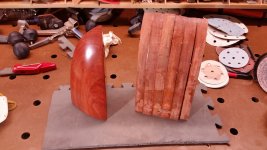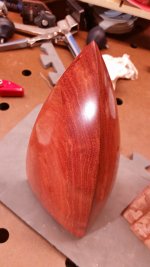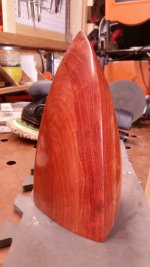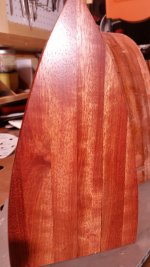ear3
Member
- Joined
- Jul 24, 2014
- Messages
- 4,342
Decided to get an early jump on DIY Xmas gifts, and so I'm fabricating a few more sets of the sharkfin bookends that I did last year:
http://festoolownersgroup.com/member-projects/last-minute-xmas-gift-sharkfin-book-ends/msg360613/#msg360613
Instead of the maple I used the first go round, this time I'm experimenting with more exotic woods. Picked up some bloodwood and sapelli at Boards and Beams in Fairfield, NJ, and this afternoon laminated some of the bloodwood pieces together for the basic form -- tomorrow I'll attack them with my new RAS, whose dust collection will no doubt protect me much better from the toxic bloodwood dust than the angle grinder I used for the first set.
Ideally I'd like to do the same finishing procedure I used the first time, which was to sand it all the way up to 2000 Platin, then buff it out with some Renaissance Wax. But not having worked with either of these species before, I'm not sure if this would be the best method. Would people recommend instead some oil first before applying the wax, or maybe forget about sanding to such a high grit and go with a varnish instead? I would really prefer to have the natural smoothness of the wood that high grit sanding produces, but I'm open to suggestions. Thanks
http://festoolownersgroup.com/member-projects/last-minute-xmas-gift-sharkfin-book-ends/msg360613/#msg360613
Instead of the maple I used the first go round, this time I'm experimenting with more exotic woods. Picked up some bloodwood and sapelli at Boards and Beams in Fairfield, NJ, and this afternoon laminated some of the bloodwood pieces together for the basic form -- tomorrow I'll attack them with my new RAS, whose dust collection will no doubt protect me much better from the toxic bloodwood dust than the angle grinder I used for the first set.
Ideally I'd like to do the same finishing procedure I used the first time, which was to sand it all the way up to 2000 Platin, then buff it out with some Renaissance Wax. But not having worked with either of these species before, I'm not sure if this would be the best method. Would people recommend instead some oil first before applying the wax, or maybe forget about sanding to such a high grit and go with a varnish instead? I would really prefer to have the natural smoothness of the wood that high grit sanding produces, but I'm open to suggestions. Thanks




